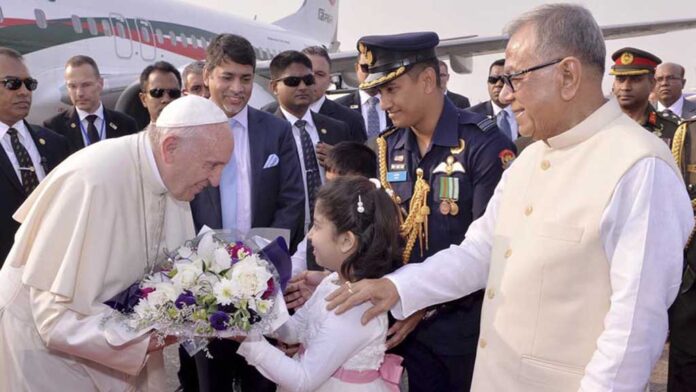Pope Francis arrived in Dhaka in November 2017, at a time when the global spotlight was focused on the Rohingya refugee crisis, and Bangladesh was grappling with the challenge of offering shelter and support to the displaced population fleeing violence in Myanmar.
His trip to Myanmar ahead of his visit to Bangladesh was expected to underscore the rights of the Rohingya people on the international stage. While he condemned the persecution in Rakhine during his stop in Naypyidaw, he was criticized for not using the term “Rohingya” at that time. However, in Dhaka, he met with members of the community and delivered a message of compassion to all displaced people.
The Christian community in Bangladesh continues to remember his three-day visit at the end of November and early December 2017 with heartfelt reverence.
They also recall the pope’s deep appreciation for Bangladesh’s religious harmony.
Father Joyanto S. Gomes, head priest of Holy Rosary Church in Tejgaon, vividly remembers his encounter with Pope Francis and the pope’s busy schedule in Dhaka eight years ago.
Reflecting on the visit, Father Joyanto told bdnews24.com that Pope Francis had led a public Mass at Suhrawardy Udyan and participated in various Christian events at churches in Kakrail and Tejgaon.
On Dec 1, 2017, during the Mass, the pope anointed 16 new priests in the presence of nearly 80,000 Christian worshippers. He prayed for the peace and well-being of the people of Bangladesh and the global community during the two-and-a-half-hour ceremony, which began at 9:30am. He also delivered a message to the followers of Christ.
Father Joyanto said, “He always advocated for peace, for protecting nature and the Earth. He stood up for the rights of the poor and suffering. He echoed these values during his Bangladesh visit.”
He added that the pope had praised Bangladesh’s inter-communal harmony, expressing hope that such coexistence would continue—a sentiment he described as deeply meaningful for the country.
“He spoke up for the rights of immigrants and refugees. During his meeting with the Rohingya, he delivered a message calling for an end to their suffering,” the father said.
The pope, who passed away at the age of 88 on Monday, was the first pontiff to visit Bangladesh in three decades. The last papal visit was by Pope John Paul II in 1986.
THREE EVENTFUL DAYS IN DHAKA
When Pope Francis, the Vatican’s head of state, landed in Dhaka on Nov 30, 2017, he was welcomed by then-President Abdul Hamid with a grand red carpet reception.
From the airport, he headed straight to the National Martyrs’ Memorial in Savar, where he laid a wreath in honor of Bangladesh’s independence heroes.
He later visited the Bangabandhu Memorial Museum in Dhanmondi to pay homage to Sheikh Mujibur Rahman, the Father of the Nation. The museum had previously been demolished following the end of Sheikh Hasina’s 15-year tenure during a student-led movement.
Afterwards, the pope had a private audience with President Hamid at Bangabhaban and later met cabinet ministers and diplomats at the Darbar Hall.
On Dec 1, he led a large open-air Mass at Suhrawardy Udyan and later held talks with Prime Minister Sheikh Hasina at the Vatican embassy.
That day also included a meeting with bishops at Ramna Cathedral in Kakrail, followed by an Interreligious and Ecumenical Meeting for Peace. It was here, in an emotional gathering with 16 Rohingya individuals from three families, that the pope publicly used the term “Rohingya” for the first time during his Asia tour.
Later, he met with bishops at the Archbishop’s House and joined another interfaith gathering focused on peace and harmony.
On his final day, Dec 3, Pope Francis visited the Mother Teresa Homes in Tejgaon in the morning, where he listened to stories of orphans and those in need.
He then met with clergy and religious figures at the Holy Rosary Church, praising Bangladesh as a model for peaceful coexistence among people of different faiths. He concluded the visit by praying at the church’s cemetery.
His final stop was at Notre Dame College, where he addressed the youth and shared a powerful message: “When a person, a society, or a religion claims to be the best, their downfall begins.”
NATION REMEMBERS THE POPE
Christian devotees have begun wearing black badges to mourn the death of Pope Francis.
His portrait has been displayed at St. Mary’s Cathedral in Kakrail, where a prayer service is also being held in his memory.
Archbishop Bejoy Nicephorus D’Cruze expressed deep sorrow over the death of the “holy father,” Pope Francis, who had just celebrated Easter.
“We are mourning. He was a humble soul who led a simple life and had immense love for the poor,” said the archbishop.
“He cared deeply for refugees, migrants, and asylum seekers, and consistently appealed to global organizations to stand up for their rights.”
“I ask everyone in Bangladesh and across the world to pray for our pope to find eternal peace,” he added.
As of now, St. Mary’s Cathedral has not announced a formal program following the pope’s death.
Father Milton Denis Corraya, chancellor of the Archdiocese of Dhaka, told bdnews24.com, “No specific event has been scheduled yet. A decision will be taken after consultation.”



